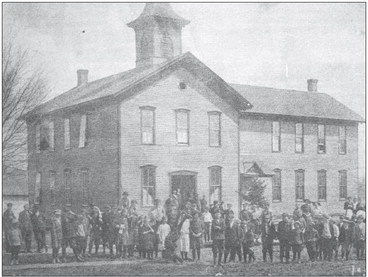Historical buildings and industry in Dorchester


Growing up in and around Dorchester, families got used to seeing businesses and buildings come and go throughout the years. The one resource settlers had plenty of in this area was wood so all buildings were made of wood early on. Even the early sidewalks were made of wooden boards that laid two feet higher than the street in some places. That led to multiple fires that destroyed buildings and forced Dorchester residents to set their sights on new buildings.
Significant fires ravaged Dorchester in 1886, 1895, 1923 and 1929. The biggest of those fires occurred in 1923 with 15 buildings including barns, a bowling alley, the post office, a drug store, a general merchandise store and multiple residences. The loss was estimated at about $150,000.
Building back stronger
One of the earliest industries that drew people to Dorchester was the Ole Paulson saw mill. Paulson came to Dorchester in 1897 and managed the Ellingson Lumber Company until 1905 when he bought the business. The mill burned in 1922 and was never rebuilt. There were a number of other mills that spanned the Dorchester area during this time as the railway allowed the lumber to be harvested, planed, stored and shipped with relative ease.
By 1890, Dorchester had many businesses including a drug store, hardware store, meat market, photography gallery, general mercantile and grocery stores, blacksmith shops, two hotels, boarding houses, a post office and bank, insurance agency, public hall, a church, school and small factories. The estimated population was 500.
Throughout the early 1900s, industry began to flourish partially due to the installation of electricity. In April of 1915 permission was granted by the Village of Dorchester to the Abbotsford Electric Company for the purpose of installing an electric light system and power plant. In August of 1939, an expansive water and sewer project was completed, giving residents constant access to water and sewer for the first time.
Over time, businesses like Liberty Homes, now, Mid-Country Homes, Nor-Wis Hardwoods, now Northwest Hardwoods, Meyer Manufacturing, Pinter’s Packing Plant, Bob’s Dairy Supply, Meyer Lumber, Parrett Windows and Doors, Westar Manufacturing and many others have made their homes in Dorchester.
Dorchester schools
At the base of every community is a school district. Dorchester featured three schools at a time but over time, schools have vacated the village. Prior to the school’s leaving, the relationship with the Colby School District allowed residents of Dorchester and the surrounding area be seamlessly integrated into the school system. The Dorchester school system wasn’t always that way. Dorchester even combined with Abbotsford for a few years.
The first school in Dorchester was built in 1874. However, due to the rapid growth of the town, a larger, two story building was built in 1876 and the first school was turned into a wood shed. An addition onto the building was created in 1903. In 1914, a two-story brick structure with a basement was constructed and ten grades, including two years of high school were taught in this building.
The first high school commencement with students completing the 12th grade was held in 1925. Graduates were: Elsie Bobbe, Frank Hunt, Marie Kaage, Jack Kronschnable, Marie Kronschnable, Ora Marks, Harold Monroe, Graydon Schultz, Henry Scidmore, Edith Sebold and Lloyd Sorenson.
The school served as an educational building until 1962. Students from Dorchester joined with the Abbotsford School District in 1961. The classes of 1962, 1963, and 1964 were known as the “Dor-Abby” graduating classes. The merger was then dissolved and students from Dorchester became a part of the Colby School District in July of 1964.
The village also touted St. Louis Catholic School (1913 - 2006) and St. Peter’s Lutheran School (1923 - 1952).
In 1950, the Dorchester village board agreed to build a community hall to serve as a place for receptions, meetings, dances and sporting activities. The space was later called Memorial Hall and still standstoday.Thehallincludedabarroom downstairs with four bowling lanes. The top floor included a hall for dining and dancing, and also has a kitchen that can be used to help cater events.
The hall was remodeled in 1967 and has been renovated multiple times since then with the latest updates including the addition of wifi at events and a refinished hall floor.
The hall now hosts events such as weddings and hosted Colby and Abbotsford prom celebrations over the past few years.
As previously mentioned, St. Louis Catholic Church (1876 - present) and St. Peter’s Lutheran Church (1879 - present) both established schools for a time in the village of Dorchester.
St. Peter’s Lutheran Church conducted services entirely in German until 1921 when English services were added. In 1948, German services were completely dropped.
St. Louis Catholic Church endured multiple fires in 1897 and 1942 that caused the community to have to rebuild the church building but the congregation remained.
Other churches included the Peace United Church of Christ (1898 - 2022) and the Salem United Methodist Church (1882 - present). These core four churches gave Christians from different denominations the ability to practice their faith every week.
After a vote in 2022, Peace United Church of Christ decided to close its doors after membership dwindled and a new pastor was to be sought if the church were to stay open.
Many other buildings including the public library, post office, village hall and others have a rich history in Dorchester. More about those can be seen on the village of Dorchester website under the Historical Center exhibits at www.dorchesterwi. com/historical-center or by setting up an appointment to go through the historical center at the Dorchester Public Library
with Jim Jantsch. Contact Jantsch at 715654-5432.
